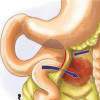
Thrombocytopenia in Pregnancy: Unmasking the Burden of Hypertensive Disorders
A
retrospective observational study conducted at Gandhi Hospital involving 200
pregnant women with thrombocytopenia sheds critical light on the spectrum of
etiologies and associated fetomaternal outcomes. The investigation identifies pregnancy-induced hypertension (PIH)
as the leading cause of thrombocytopenia, accounting for 44% (88 cases) of all cases, followed
by gestational thrombocytopenia,
which presented with relatively benign clinical consequences.
A
notable finding was the significantly higher incidence of placental abruption among women with
PIH, particularly those diagnosed with HELLP
syndrome (Hemolysis, Elevated Liver enzymes, and Low Platelets). These
hypertensive disorders were also linked with an increased risk of preterm delivery, intrauterine growth restriction (IUGR),
and intrauterine fetal demise (IUFD)underlining
the importance of vigilant antenatal surveillance.In contrast, gestational
thrombocytopenia, typically diagnosed incidentally, demonstrated favorable maternal and neonatal outcomes,
with minimal complications and a low risk of disease progression.
These
findings reinforce the need for early
identification and stratification of thrombocytopenia during pregnancy
to differentiate between benign and pathological causes, enabling timely
intervention and improved perinatal outcomes.
Source: Shah, S., Sravanthi, K.,
Omini, K., &Mitra, M. (2025). Clinical profile and outcome of
thrombocytopenia in pregnancy. Indian Journal of Obstetrics and Gynecology
Research, 12(1), 103–108. https://doi.org/10.18231/j.ijogr.2025.019














Please login to comment on this article